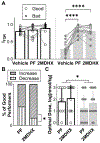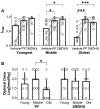Dopamine D1 Receptor Agonists Rescue Age-related Decline in Temporal Order Memory
- PMID: 38823551
- PMCID: PMC11246218
- DOI: 10.1016/j.neuroscience.2024.05.033
Dopamine D1 Receptor Agonists Rescue Age-related Decline in Temporal Order Memory
Abstract
Dopamine D1 receptor agonists improve spatial working memory, but their effects on temporal order memory, particularly prone to the effects of aging, have not been studied. Two D1 agonists, PF6256142 (PF) and 2-methyldihydrexidine (2MDHX), were examined for their effects in a rodent temporal order recognition task. Our results are consistent with the hypothesis that there is an age-related decline in rodent temporal order memory. The data also show that either agonist rescues the poor memory performance with a large effective size. Interestingly, the optimal effective dose varied among individual rats of different age groups. PF showed greater potency for older rats, whereas 2MDHX showed better overall population effectiveness. Both PF and 2MDHX have high intrinsic activity at rodent D1-mediated cAMP synthesis. Conversely, at D1-mediated β-arrestin recruitment, PF has essentially no intrinsic activity, whereas 2MDHX is a super-agonist. These findings suggest that D1 agonists have potential to treat age-related cognitive decline, and the pattern of functional selectivity may be useful for developing drugs with an improved therapeutic index.
Keywords: age-related cognitive decline; dopamine D1 agonist; functional selectivity/signaling bias; temporal order recognition; working memory.
Copyright © 2024 IBRO. Published by Elsevier Inc. All rights reserved.
Conflict of interest statement
Conflict of Interest:
RBM is a consultant for Cerevel Therapeutics, and also is an inventor of D1-related technology. His conflicts of interests have been disclosed and are managed by the Pennsylvania State University.
Figures



Similar articles
-
The Black Book of Psychotropic Dosing and Monitoring.Psychopharmacol Bull. 2024 Jul 8;54(3):8-59. Psychopharmacol Bull. 2024. PMID: 38993656 Free PMC article. Review.
-
Short-Term Memory Impairment.2024 Jun 8. In: StatPearls [Internet]. Treasure Island (FL): StatPearls Publishing; 2025 Jan–. 2024 Jun 8. In: StatPearls [Internet]. Treasure Island (FL): StatPearls Publishing; 2025 Jan–. PMID: 31424720 Free Books & Documents.
-
Systemic pharmacological treatments for chronic plaque psoriasis: a network meta-analysis.Cochrane Database Syst Rev. 2021 Apr 19;4(4):CD011535. doi: 10.1002/14651858.CD011535.pub4. Cochrane Database Syst Rev. 2021. Update in: Cochrane Database Syst Rev. 2022 May 23;5:CD011535. doi: 10.1002/14651858.CD011535.pub5. PMID: 33871055 Free PMC article. Updated.
-
Systemic pharmacological treatments for chronic plaque psoriasis: a network meta-analysis.Cochrane Database Syst Rev. 2017 Dec 22;12(12):CD011535. doi: 10.1002/14651858.CD011535.pub2. Cochrane Database Syst Rev. 2017. Update in: Cochrane Database Syst Rev. 2020 Jan 9;1:CD011535. doi: 10.1002/14651858.CD011535.pub3. PMID: 29271481 Free PMC article. Updated.
-
The effectiveness and cost-effectiveness of carmustine implants and temozolomide for the treatment of newly diagnosed high-grade glioma: a systematic review and economic evaluation.Health Technol Assess. 2007 Nov;11(45):iii-iv, ix-221. doi: 10.3310/hta11450. Health Technol Assess. 2007. PMID: 17999840
References
-
- Andersen PH, Jansen JA, 1990. Dopamine receptor agonists: selectivity and dopamine D1 receptor efficacy. European journal of pharmacology 188(6), 335–347. - PubMed
-
- Arnsten AF, Cai JX, Murphy BL, Goldman-Rakic PS, 1994. Dopamine D1 receptor mechanisms in the cognitive performance of young adult and aged monkeys. Psychopharmacology (Berl) 116(2), 143–151. - PubMed
MeSH terms
Substances
Grants and funding
LinkOut - more resources
Full Text Sources
Medical

